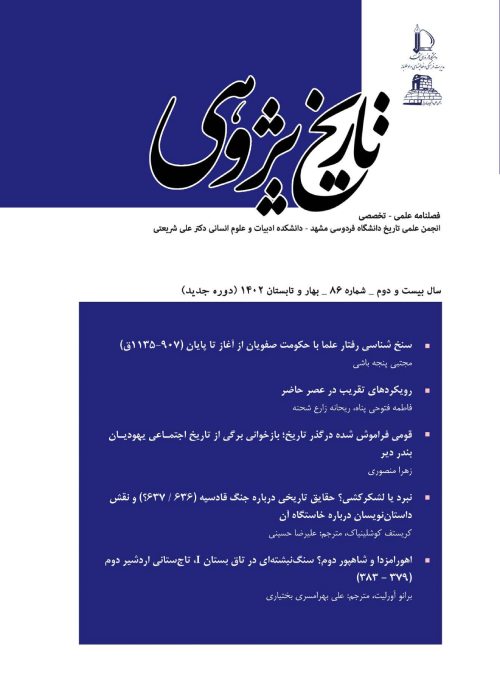فهرست مطالب

نشریه تاریخ پژوهی
پیاپی 86 (بهار و تابستان 1402)
- تاریخ انتشار: 1402/05/24
- تعداد عناوین: 5
-
صفحات 33-50
-
Pages 33-50
There are numerous approaches and perceptions of Islamic assimilation and unity, and it is impossible to have them all in one category. This is so due to the dynamic nature of human thought field and the object of human mind, i.e. human being. Some individuals refer to assimilation as negating Islamic denominations and moving back to Saleh-Salaf tradition, some propagate a version of Islam without denominations, and some chant the slogan of embracing the common grounds and negating the discrepancies.The major purpose of the writers of this paper is to consider different aspects and approaches to assimilation in the contemporary era so that it can shed light on the fact that the activists in this field do not demonstrate unanimous outlooks on this field and they tend to view it from their own lenses. This study, through a descriptive-analytic approach and library method, attempts to scrutinize the different dimension of this subject through raising the questions of “How many subcategories of corresponding approaches to the assimilation of denomination disciples exist?« and “ What are their communal and differential points?”. The findings of this research indicate that currently there are approaches of accentuating the common grounds and referring to one another as making excuse(the first), revising differential issues(the second), pragmatic(the third), explanatory(the fourth), pluralist(the fifth), secularism(the sixth), a separation-inclined approach (the seventh). Explaining one’s religious teachings to their opposing group (the fourth), accepting different approaches to assimilation somehow separation of Islam from politics (fifth and sixth), and Ahl al--Bayt’s religious authority are considered as their communal and differential points.
Keywords: Islamic world, Islamic unity, Assimilation, Approaches to assimilation -
Pages 51-70
The Jews of Iran whose history in this land dates back to the time of the Achaemenids as evidenced by historical sources were scattered and perpetuated in different periods in different regions of Iran. The coastal areas of the Persian Gulf, including the important commercial port of Najirim (the current Dayyer᾿s port) in ancient times, were the residence of a group of this religious minority of businessmen until less than a hundred years ago. Despite of little historical information from the Jews of Dayyer port, no more information is available about the social life, Customs and other political economic interactions of this minority in historical sources. Therefore, in this search, efforts have been made to clarify corners of their social history to those interested with the help of oral memory. This study, in response to the question of what was the place of this wealthy religious minority in the social and political interactions of Dayyer᾿s port, was? And has their superior economic position brought them privileges over other residents? It examines the different corners of their socioeconomic life in two ways: library, field (interview) methods. Oral findings suggest that in political interactions, the minority's superior economic position over other residents could have balanced power in their favor. However, social isolation due to the closed nature of their religious community caused them to have a lower position in social relations and civil rights than others.
Keywords: Iranian jews, population, Dayyer᾿s port, migration

